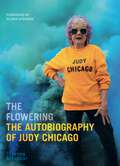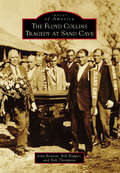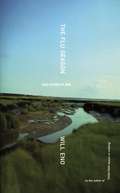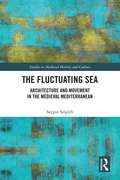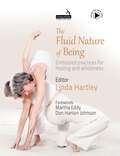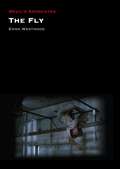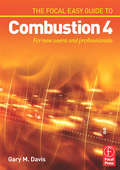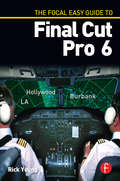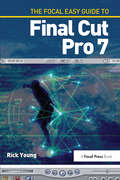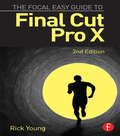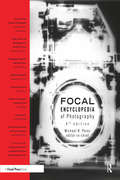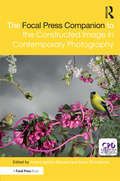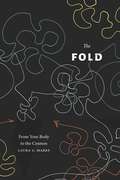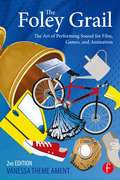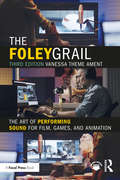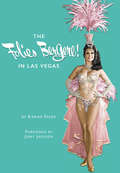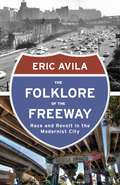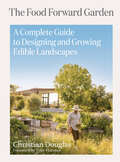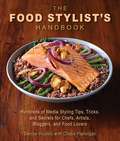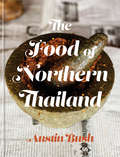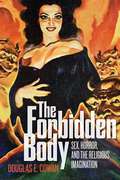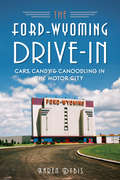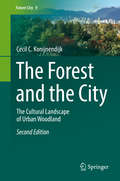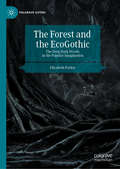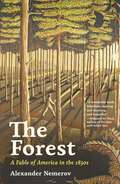- Table View
- List View
The Flowering: The Autobiography Of Judy Chicago
by Judy ChicagoIn this provocative and resonant autobiography, world-renowned artist and feminist icon Judy Chicago reflects on her extraordinary life and career. Judy Chicago is America’s most dynamic living artist. Her works comprise a dizzying array of media from performance and installation to the glittering table laid for thirty-nine iconic women in The Dinner Party (now permanently housed at the Brooklyn Museum), the groundbreaking Birth Project, and the meticulously researched Holocaust Project. She designed the monumental installation for Dior’s 2020 Paris couture show and, in 2019, established the Judy Chicago Portal, which will help to accomplish her lifelong goal of overcoming the erasure that has eclipsed the achievements of so many women. The Flowering is her vivid and revealing autobiography, fully illustrated with photographs of her work, as well as never-before-published personal images and a foreword by Gloria Steinem. Chicago has revised and updated her earlier, classic works with previously untold stories, fresh insights, and an extensive afterword covering the last twenty years. This powerful narrative weaves together the stories behind some of Chicago’s most significant artworks and her journey as a woman artist with the chronicles of her personal relationships and her understanding, from decades of experience and extensive research, of how misogyny, racism, and other prejudices intersect to erase the legacies of artists who are not white and male while dismissing the suffering of millions of creatures who share the planet. With the first career retrospective of her work forthcoming at the de Young Museum in 2021, Chicago reinforces her message of resilience for a new generation of artists and activists. The Flowering is an essential read for anyone interested in making change.
The Floyd Collins Tragedy at Sand Cave (Images of America)
by John Benton Bob Thompson Bill NapperFloyd Collins is perhaps the most famous person you have probably never heard of. Collins was a Kentucky cave explorer who was trapped for more than two weeks during the winter of 1925 in a cave located within the boundaries of what is now Mammoth Cave National Park. Collins had no fear of exploring the most difficult cave passages, and few people could match his persistence and endurance. The story of Floyd Collins becoming trapped, then buried alive, and ultimately dying alone in a cave held a powerful grip on the hearts and minds of people the world over. The resulting media coverage put Mammoth Cave on the map and helped usher the actual designation of Mammoth Cave as a national park. His explorations laid the foundation for others to later discover that Mammoth Cave was the longest cave in the world.
The Flu Season and Other Plays
by Will Eno"Will Eno is one of the finest younger playwrights I have come across in a number of years. His work is inventive, disciplined and, at the same time, wild and evocative. His ear is splendid and his mind is agile."--Edward Albee "An original, a maverick wordsmith whose weird, wry dramas gurgle with the grim humor and pain of life. Eno specializes in the connections of the unconnected, the apologetic murmurings of the disengaged."--Guardian Winner of the 2004 Oppenheimer Award for best New York debut by an American playwright, The Flu Season is a reluctant love story, in spite of itself. Set in a hospital and a theater, it is a play that revels in ambivalence and derives a flailing energy from its doubts whether a love story is ever really a love story. Will Eno has been called "a Samuel Beckett for the Jon Stewart generation" (The New York Times)--he is a playwright with an extraordinary voice and a singular theatrical vision. Also included in this volume are Tragedy: A Tragedy and Intermission.
The Fluctuating Sea: Architecture and Movement in the Medieval Mediterranean (Studies in Medieval History and Culture)
by Saygin SalgirliThis volume fluctuates between conceptualizations of movement; either movements that buildings in the medieval Mediterranean facilitated, or the movements of the users and audiences of architecture. From medieval Anatolia to Southern France and the Genoese colony of Pera across Constantinople, The Fluctuating Sea investigates how the relationship between movement and the experiences of a multiplicity of users with different social backgrounds can provide a new perspective on architectural history. The book acknowledges the shared characteristics of medieval Mediterranean architecture, but it also argues that for the majority of people inhabiting the fragmented microecologies of the Mediterranean, architecture was a highly localized phenomenon. It is the connectivity of such localized experiences that The Fluctuating Sea uncovers. The Fluctuating Sea is a valuable source for students and scholars of the medieval Mediterranean and architectural history.
The Fluid Nature of Being: Embodied practices for healing and wholeness
by Linda HartleyThe Fluid Nature of Being is a collection of writings by practitioners of Integrative Bodywork & Movement Therapy (IBMT), an approach to somatic movement education and therapy. The cultivation of consciously embodied movement is at the heart of somatic movement practice. Through embodiment practices, soma - the subjectively experienced sense of embodied self - becomes a vital, living reality and a foundation through which healthy relationship to others, to Nature, and to life as a whole can be nourished.The book describes the practice, thinking, research and creative work of twenty-one IBMT practitioners. Each has also trained in other disciplines and their writing weaves together their broader learning, passion and professional practice within the IBMT approach to somatic work. In this volume we offer a collection of expressions with a rich diversity of themes and styles, bringing these voices from the next generation of somatic movement practitioners, writers and leaders to a wider audience.The book covers topics such as IBMT in therapy, education, early years learning, dance and theatre; the integration with psychotherapy, psychoanalytic thinking, and somatic trauma therapy; and the connection between individual healing and the healing of the Earth and Nature during this time of planetary crisis.There are many aspects of IBMT practice described in this book that are shared with somatic practices in general, though there are also aspects which are specific to this approach. IBMT uniquely integrates in-depth studies in Somatic Psychology and the Discipline of Authentic Movement into a foundation of Body-Mind Centering® training. At the core of the practice is the quest to deepen connection with self, and from there, connection with others and the world around us.
The Fly (Devil's Advocates)
by Emma WestwoodIt's not often that a remake outshines its original but David Cronenberg's "reimagining" of The Fly (1986) is one of those rare exceptions. Equal parts horror, science fiction, and romance, The Fly takes the premise of its 1958 original—a man unintentionally fusing with a housefly during an experiment in teleportation—and reinterprets the plot as a gradual cellular metamorphosis between these two organisms.This book teases out the intricate DNA of The Fly and how it represents the personalities of many authors, including a distinguished history of Man-as-God tales stretching back to Mary Shelley's Frankenstein (1818). Drawing from interviews with cast, crew, film commentators, and other filmmakers, Emma Westwood interlaces the "making of" travails of The Fly with why it is one of the most important examples of master storytelling ever committed to screen.
The Focal Easy Guide to Combustion 4: For New Users and Professionals
by Gary M DavisSoftware programs are complex, the books that explain them shouldn't be. This thoroughly illustrated, full-color guide explains everything you need to know to get up and running quickly with Combustion. Get a jump-start learning the major features or the software without bogging you down with unnecessary detail.The author shares his professional insight and extensive training experience to ensure you'll get the most out of all the professional paint, animation, editing and 3D compositing tools Combustion offers. Also featured are many workflow tips which show how to tap into the full power of Combustion 4 in your effects and motion graphics work.For useful tips and tutorials, visit the book's companion site at www.focalpress.com/companions/0240520106
The Focal Easy Guide to Final Cut Pro 6
by Rick YoungSoftware packages are complex. Software books don't need to be. Simplify your life with The Focal Easy Guide to Final Cut Pro! This concise, full-color book lives up to its name by paring down the software to its essentials. You learn the key features and essential workflow to get you up and running in no time. With this book you can start cutting immediately, whatever you edit, whatever the format. This is an ideal introduction whether you are a professional moving over to Final Cut Pro from another package or system, a new user, or just someone who wants to get the best results from Final Cut Pro, fast!
The Focal Easy Guide to Final Cut Pro 7
by Rick YoungRick Young's Easy Guide to Final Cut Pro 7 is the ultimate guide to getting up and running with Apple's professional editing software. Full of information relevant to both new users and professionals, this book wastes no time in teaching all the vital knowledge needed to edit your project from start to finish using Final Cut Pro. All the key features and essential techniques are presented in this easy to understand, full-color book. When time is of the essence, less is more. Learn invaluable workflow tips which show you how to tap into the full power of Final Cut Pro, whichever version of the program you are using. All the essential areas are covered: *System Set-up * Capture * Editing * Audio Mixing * Effects * Output * Media * Management, and more This latest edition also features new sections specific to Final Cut Pro 7, including expanded ProRes support, improved markers, global transitions, alpha transitions, automatic transfer of file-based media to hard drive, and easy export to DVD, Blu-Ray, iPod, iPhone, and Apple TV.Praised by industry professionals, educators, and independent filmmakers, the Easy Guide to Final Cut Pro has earned a solid reputation as being the absolute best book on the market for those wishing to get up to speed with Final Cut Pro quickly.
The Focal Easy Guide to Final Cut Pro X
by Rick YoungMaster invaluable workflow tips that will allow you to tap into the full power of Final Cut Pro X and achieve results quickly, regardless of your skill level. Rick Young’s Focal Easy Guide to Final Cut Pro X, Second Edition is the ultimate mentor for getting up and running with Apple’s professional editing software. In this step-by-step, full-color guide, Young clearly explains the key concepts and vital knowledge you need to edit your project from start to finish, providing clear, time-saving instruction on producing and outputting using Final Cut Pro X. This new edition has been updated to include: A thorough introduction to Final Cut Pro X and the philosophy by which the software works Coverage of the complete postproduction process, including setup, importing, editing, audio, effects, and output Additional sections on Multicam Editing, working with Proxies, and effective media management of Libraries Instruction on encoding, distributing, and archiving your completed projects A companion website (www.focalpress.com/9781138785533) featuring downloadable video footage that you can edit using the techniques covered in the book Packed with tutorials and real-world examples, The Focal Easy Guide to Final Cut Pro X, Second Edition will take you through the ins and outs of the software and have you editing and outputting your movies in no time! Written for Final Cut Pro X version 10.1.3 and beyond.
The Focal Encyclopedia of Photography: From The First Photo On Paper To The Digital Revolution
by Michael R. PeresThis volume is a complete revision of the 1996 third edition, shares the ever-changing breadth of photographic topics with a special emphasis on digital imaging and contemporary issues. Produced by an international team of photographic and imaging experts with collaboration from the George Eastman House (the world's oldest photography museum), this fourth edition contains essays and photographic reproductions sharing information where photography and imaging serve a primary role, ranging from the atomic to the cosmic.
The Focal Press Companion to the Constructed Image in Contemporary Photography
by Marni Shindelman Anne Leighton MassoniThis compendium examines the choices, construction, inclusions and exemptions, and expanded practices involved in the process of creating a photograph. Focusing on work created in the past twenty-five years, this volume is divided into sections that address a separate means of creating photographs as careful constructs: Directing Spaces, Constructing Places, Performing Space, Building Images, and Camera-less Images. Introduced by both a curator and a scholar, each section features contemporary artists in conversation with curators, critics, gallerists, artists, and art historians. The writings include narratives by the artist, writings on their work, and examinations of studio practices. This pioneering book is the first of its kind to explore this topic beyond those artists building sets to photograph.
The Fold: From Your Body to the Cosmos
by Laura U. MarksIn The Fold, Laura U. Marks offers a practical philosophy and aesthetic theory for living in an infinitely connected cosmos. Drawing on the theories of Leibniz, Glissant, Deleuze, and theoretical physicist David Bohm—who each conceive of the universe as being folded in on itself in myriad ways—Marks contends that the folds of the cosmos are entirely constituted of living beings. From humans to sandwiches to software to stars, every entity is alive and occupies its own private enclosure inside the cosmos. Through analyses of fiction, documentary and experimental movies, interactive media, and everyday situations, Marks outlines embodied methods for detecting and augmenting the connections between each living entity and the cosmos. She shows that by affectively mediating with the ever-shifting folded relations within the cosmos, it is possible to build “soul-assemblages” that challenge information capitalism, colonialism, and other power structures and develop new connections with the infinite. With this guide for living within the enfolded and unfolding cosmos, Marks teaches readers to richly apprehend the world and to trace the processes of becoming that are immanent within the fold.
The Foley Grail: The Art of Performing Sound for Film, Games, and Animation
by Vanessa Theme AmentMaster classic and cutting-edge Foley techniques that will allow you to create rich, convincing sound for any medium, be it film, television, radio, podcasts, animation, or games. In The Foley Grail, Second Edition award-winning Foley artist Vanessa Theme Ament teaches you how Foley is designed, crafted, and edited for any project, right down to the nuts and bolts of spotting, cueing, and performing sounds. Various renowned sound artists provide a treasure trove of shortcuts, hot tips, and other tricks of the trade. This new edition features: Entirely new chapters dedicated to Foley in games, television, broadcasting, and animation, as well as what is new in sound for media education All new sound "recipes" that include proven Foley methods you can immediately use on your own projects New case studies from well-known films, shows, games, and animations Interviews with current sound artists from across the globe An extensive companion website (www.focalpress.com/cw/ament) featuring video demonstrations of Foley artists at work, video tutorials of specific Foley techniques, lectures from the author, and much more
The Foley Grail: The Art of Performing Sound for Film, Games, and Animation
by Vanessa Theme AmentThis book teaches you how to master classic and cutting edge Foley techniques in order to create rich and convincing sound for any medium, be it film, television, radio, podcasts, animation, or games. Award-winning Foley artist Vanessa Theme Ament demonstrates how Foley is designed, crafted, and edited for any project, down to the nuts and bolts of spotting, cueing, and performing sounds. Various renowned sound artists provide a treasure trove of indispensable shortcuts, hot tips, and other valuable tricks of the trade. This updated third edition features the following: New chapters dedicated to Foley in games, television, broadcasting, and animation, as well as what is new in sound for media education A multitude of sound "recipes" that include proven Foley methods you can immediately use on your own projects A diverse range of case studies from well-known films, shows, games, and animation Interviews with current sound artists from around the world By exploring the entire audio post-production process, this book provides you with an excellent understanding of where Foley fits in the business of filmmaking and is a perfect guide for both newcomers and experienced sound designers wanting to learn more about this art. Accompanying the book are online resources featuring video demonstrations of Foley artists at work, video tutorials of specific Foley techniques, lectures from the author and more.
The Folies Bergere in Las Vegas
by Karan Feder Jerry JacksonDebuting at the Tropicana Hotel on Christmas Eve, 1959, at a reported cost of one quarter-million dollars (over two million in today's dollars), the Folies Bergere stage show featured a cast of "eighty stars" and promised an elegant evening of sensual entertainment complete with sensational song and dance numbers, curious novelty acts, and exquisite leggy showgirls. Imported directly from Paris, the iconic French production, famed for its elegant and chic legacy, was a mainstay on the Las Vegas Strip for nearly half a century. A 1959 Las Vegas Sun newspaper article portends the significant role that the Folies Bergere would play in the city's history: "From beginning to end this is the most dazzling entertainment which any city has been privileged to see. It's saucy, piquant and racy in the splendidly provocative French way. Las Vegas, the entertainment capital of the world, is now no idle boast."
The Folklore of the Freeway: Race and Revolt in the Modernist City (A Quadrant Book)
by Eric AvilaWhen the interstate highway program connected America&’s cities, it also divided them, cutting through and destroying countless communities. Affluent and predominantly white residents fought back in a much heralded &“freeway revolt,&” saving such historic neighborhoods as Greenwich Village and New Orleans&’s French Quarter. This book tells of the other revolt, a movement of creative opposition, commemoration, and preservation staged on behalf of the mostly minority urban neighborhoods that lacked the political and economic power to resist the onslaught of highway construction.Within the context of the larger historical forces of the 1960s and 1970s, Eric Avila maps the creative strategies devised by urban communities to document and protest the damage that highways wrought. The works of Chicanas and other women of color—from the commemorative poetry of Patricia Preciado Martin and Lorna Dee Cervantes to the fiction of Helena Maria Viramontes to the underpass murals of Judy Baca—expose highway construction as not only a racist but also a sexist enterprise. In colorful paintings, East Los Angeles artists such as David Botello, Carlos Almaraz, and Frank Romero satirize, criticize, and aestheticize the structure of the freeway. Local artists paint murals on the concrete piers of a highway interchange in San Diego&’s Chicano Park. The Rondo Days Festival in St. Paul, Minnesota, and the Black Archives, History, and Research Foundation in the Overtown neighborhood of Miami preserve and celebrate the memories of historic African American communities lost to the freeway.Bringing such efforts to the fore in the story of the freeway revolt, The Folklore of the Freeway moves beyond a simplistic narrative of victimization. Losers, perhaps, in their fight against the freeway, the diverse communities at the center of the book nonetheless generate powerful cultural forces that shape our understanding of the urban landscape and influence the shifting priorities of contemporary urban policy.
The Food Forward Garden: A Complete Guide to Designing and Growing Edible Landscapes
by Christian DouglasDiscover a high-style approach to vegetable gardening from award-winning landscape designer Christian Douglas. What if, instead of relegating our vegetable patch to a remote corner of the backyard, we brought it forward? What if we integrated edibles into our decorative landscapes, letting vegetables, herbs, fruits, and berries share prime real estate alongside our patios, pools, even our front walkways? Equal parts inspiration and instruction, and filled with an abundance of ideas and information, The Food Forward Garden is a lushly illustrated guide to how we can make better use of our outdoor spaces without sacrificing style. In this comprehensive manual, award-winning landscape designer Christian Douglas shows us how the intrinsic beauty and seasonal rhythms of edibles bring a new level of purpose, meaning, and stunning visual pleasure to the home garden.
The Food Stylist's Handbook: Hundreds of Media Styling Tips, Tricks, and Secrets for Chefs, Artists, Bloggers, and Food Lovers
by Denise Vivaldo Cindie FlanniganAcclaimed food stylist Denise Vivaldo shares the tips and secrets of the trade with cooks and foodies alike who want to become master stylists. It takes a steady hand to arrange the chocolate curls and drizzle the caramel sauce in elaborate designs on top of that sumptuous tiered cake. Whether for food blogs, television, books, magazines, movies, menus, or advertising, food stylists and photographers learn to slice, plate, tweak, and arrange so the dish becomes less a bit of food and more the work of an artisan.With Denise and coauthor Cindie Flannigan’s help, you’ll find out how to get started, what equipment you’ll need, how to find clients, tips to staying successful in the business, and—most importantly—how to craft and style food (and products that appear to be food) so it all looks delicious from every angle.This paperback edition of The Food Stylist’s Handbook has been fully updated and revised to help current culinary professionals, armchair chefs, bloggers, and food photographers understand how to make every picture tell a story.
The Food of Northern Thailand
by Austin BushFood of Northern Thailand is a beautiful deep dive into the regional cuisine of northern Thailand with a documentarian's approach and a photographer's eye.The food of northern Thailand is a world away from the highly refined, royal court- and Chinese-influenced style of cooking in Bangkok--the Thai food that most of us are familiar with. It's a cuisine with its own distinct identity, one that is rustic and earthy, meaty and fragrant; one with roots in the Thai repertoire but with branches that extend into unfamiliar areas; a cuisine that feels ancient, but is ever evolving. A writer, photographer, and travel-guide writer, Austin Bush has lived in Thailand for nearly 20 years. In this book, Bush travels across northern Thailand to talk to the region's home cooks, academics, restaurateurs, writers, and hawkers. Their recipes and stories, along with Bush's photographs, capture the people, countryside, markets, and of course, dishes and cooking techniques of northern Thailand. Each of the chapters in the book will focus on a single province, giving a snapshot of the dishes, staple ingredients, cooking methods, and people specific to that area.
The Forbidden Body: Sex, Horror, and the Religious Imagination
by Douglas E. CowanFrom creature features to indie horror flicks, find out what happens when sex, horror, and the religious imagination come togetherThroughout history, religion has attempted to control nothing so much as our bodies: what they are and what they mean; what we do with them, with whom, and under what circumstances; how they may be displayed—or, more commonly, how they must be hidden. Yet, we remain fascinated, obsessed even, by bodies that have left, or been forced out of, their “proper” place. The Forbidden Body examines how horror culture treats these bodies, exploring the dark spaces where sex and the sexual body come together with religious belief and tales of terror.Taking a broad approach not limited to horror cinema or popular fiction, but embracing also literary horror, weird fiction, graphic storytelling, visual arts, and participative culture, Douglas E. Cowan explores how fears of bodies that are tainted, impure, or sexually deviant are made visible and reinforced through popular horror tropes. The volume challenges the reader to move beyond preconceived notions of religion in order to decipher the “religious imagination” at play in the scary stories we tell over and over again. Cowan argues that stories of religious bodies “out of place” are so compelling because they force us to consider questions that religious belief cannot comfortably answer: Who are we? Where do we come from? Why do we suffer? And above all, do we matter? As illuminating as it is unsettling, The Forbidden Body offers a fascinating look at how and why we imagine bodies in all the wrong places.
The Ford-Wyoming Drive-In: Cars, Candy And Canoodling In The Motor City (Landmarks)
by Karen DybisShortly after World War II, three Dearborn brothers bought a vacant parcel to build a drive-in theater. Local groups opposed them, fearing such a place would elicit "immoral behavior." But the Clark family persevered to see its movie palace become a Metro Detroit mainstay, hosting celebrities, rock stars and a never-ending line of families with kids in footie pajamas. A handshake transferred ownership to movie magnate Charles Shafer and his business partner, Bill Clark, who expanded the theater to a massive nine screens. But blockbusters and hordes of teens couldn't mitigate the effects of Detroit's decline, auto company bankruptcies and Michigan's economic malaise. Despite it all, the mighty Ford-Wyoming kept the movies showing, bringing a bit of Hollywood glamour to the gritty Motor City.
The Forest and the City: The Cultural Landscape Of Urban Woodland
by Cecil C. KonijnendijkAmsterdamse Bos, Bois de Boulognes, Epping Forest, Hong Kong’s country parks, Stanley Park: throughout history cities across the world have developed close relationships with nearby woodland areas. In some cases, cities have even developed – and in some cases are promoting – a distinct ‘forest identity’. This book introduces the rich heritage of these city forests as cultural landscapes, and shows that cities and forests can be mutually beneficial.Essential reading for students and researchers interested in urban sustainability and urban forestry, this book also has much wider appeal. For with city forests playing an increasingly important role in local government sustainability programs, it provides an important reference for those involved in urban planning and decision making, public affairs and administration, and even public health. From providers of livelihoods to healthy recreational environments, and from places of inspiration and learning to a source of conflict, the book presents examples of city forests from around the world. These cases clearly illustrate how the social and cultural development of towns and forests has often gone hand in hand. They also reveal how better understanding of city forests as distinct cultural and social phenomena can help to strengthen synergies both between cities and forests, and between urban society and nature.
The Forest and the EcoGothic: The Deep Dark Woods in the Popular Imagination (Palgrave Gothic)
by Elizabeth ParkerThis book offers the first full length study on the pervasive archetype of The Gothic Forest in Western culture. The idea of the forest as deep, dark, and dangerous has an extensive history and continues to resonate throughout contemporary popular culture. The Forest and the EcoGothic examines both why we fear the forest and how exactly these fears manifest in our stories. It draws on and furthers the nascent field of the ecoGothic, which seeks to explore the intersections between ecocriticism and Gothic studies. In the age of the Anthropocene, this work importantly interrogates our relationship to and understandings of the more-than-human world. This work introduces the trope of the Gothic forest, as well as important critical contexts for its discussion, and examines the three main ways in which this trope manifests: as a living, animated threat; as a traditional habitat for monsters; and as a dangerous site for human settlement. This book will appeal to students and scholars with interests in horror and the Gothic, ecohorror and the ecoGothic, environmentalism, ecocriticism, and popular culture more broadly. The accessibility of the subject of ‘The Deep Dark Woods’, coupled with increasingly mainstream interests in interactions between humanity and nature, means this work will also be of keen interest to the general public.
The Forest: A Fable of America in the 1830s
by Alexander NemerovA vivid historical imagining of life in the early United States&“One of the richest books ever to come my way.&”—Annie Proulx, Pulitzer Prize–winning author of The Shipping News&“This is a wonderful book. . . . An extraordinary achievement.&”—Edmund de Waal, New York Times bestselling author of The Hare with Amber EyesSet amid the glimmering lakes and disappearing forests of the early United States, The Forest imagines how a wide variety of Americans experienced their lives. Part truth, part fiction, and featuring both real and invented characters, the book follows painters, poets, enslaved people, farmers, and artisans living and working in a world still made largely of wood. Some of the historical characters—such as Thomas Cole, Margaret Fuller, Nathaniel Hawthorne, Fanny Kemble, Edgar Allan Poe, and Nat Turner—are well known, while others are not. But all are creators of private and grand designs.The Forest unfolds in brief stories. Each episode reveals an intricate lost world. Characters cross paths or go their own ways, each striving for something different but together forming a pattern of life. For Alexander Nemerov, the forest is a description of American society, the dense and discontinuous woods of nation, the foliating thoughts of different people, each with their separate shade and sun. Through vivid descriptions of the people, sights, smells, and sounds of Jacksonian America, illustrated with paintings, prints, and photographs, The Forest brings American history to life on a human scale.Published in association with the Center for Advanced Study in the Visual Arts, National Gallery of Art, Washington, DC
